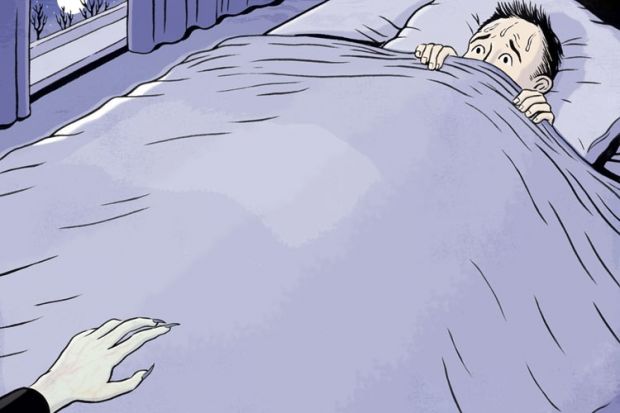Source: Daniel Mitchell
As the vampire capes are dusted off once again for innumerable Halloween parties, it’s worth reminding ourselves about the contrast between modern “vampotainment” and the genuine terror inspired by the vampires of folklore.
For hundreds of years, vampire beliefs had a vital sociological function. The vampire was often the prime scapegoat for death or disease (and occasionally even for severe weather). Exhuming the person who had died most recently, peasants might find (or claim to find) the corpse undecayed. This would then be judged a vampire, and destroyed by various means, from religious exorcism to staking, decapitation and burning.
While this scapegoating is comprehensible enough, matters become more puzzling when we hear of how the vampire visited people in bed at night. It would seem to paralyse its victims, creeping up towards them as they lay in helpless terror. Then the creature would be on their chest, a crushing weight, sucking the life (not always the blood) from their mouth and lungs. Not only that, but victims might swear that they saw the figure of a recently dead person. Surprisingly, they were probably not lying. Those visited commonly experienced a combination of sleep paralysis and nightmares, and along with the breathless impotence of the former, the latter can involve an indescribable sense of terror or doom. With the sufferer in a kind of third state between sleep and waking, their hallucinations seemed overpoweringly real.
Imagine how this felt in some demon-haunted village 200 or 300 years ago. In the case of Peter Plogojowitz, who died in Serbia in 1725, the dead man’s victims told of how Plogojowitz had “come to them in their sleep, laid himself on them, and throttled them, so that they would have to give up the ghost”. And in 1888, the head of a Cretan monastery wrote of how, “the common practice of the vrykolakes [Greek vampires] is to seat themselves upon those who are asleep and by their enormous weight to cause an agonizing sense of oppression. There is great danger that the sufferer in such cases may expire.”
The claim that vampire nightmares could actually kill sufferers may not have been an exaggeration. Around 1738, during the protracted aftermath of the Serbian vampire Arnold Paole, a young girl “named Stanoska…went to bed in perfect health, but awoke in the middle of the night, trembling, and crying out, that the son of the Heyduke Millo, who died about nine weeks before, had almost strangled her while she was asleep. From that time, she fell into a languishing state, and died at three days end.” This sounds very like what would later be termed “voodoo death”. In various tribal contexts anthropologists and doctors have seen people who believed themselves bewitched enter a state of hopeless physiological shutdown, and die in a period of one to three days. Did these people essentially die of fear and of belief in magic?
Some time after 1900, Edith Durham, the Balkan traveller and folklorist, heard of a vampire panic near Vlasenica in Bosnia. Here the main cause of death was probably typhus fever. But when Durham talks of how “the lampir was seen and heard by many people”, she is almost certainly referring to sleep paralysis nightmares. Citing a total of 15 deaths, she then adds: “It would be interesting to know how many of these died because they believed they must die. The peasants all through Albania, and Macedonia are extraordinarily affected mentally if they believe they must die, and seem to make no effort whatever to live. In Albania, I heard of more than one case in which a man’s death having been foretold by reading the future in fowls’ bones, he proceeded to sicken and die.”
What else inspired vampire panics? In some cases, the supposedly undead were simply not dead. In Belgrade in 1888, “the police found…lying in the street, the body of a man apparently frozen to death”. Failing in their attempts to revive him, the officers handed the man over to the family for interment. As the bereaved were travelling to the cemetery, “the driver of the hearse told the priest…that he heard some noise in the coffin”. Scared witless, everyone except the driver fled into the snowy night, terrified “lest a vampire should issue from [the coffin] and attack them”. Left alone, the traumatised driver spun around his carriage and whipped the horses double-speed to the nearest police station. By the time he reached it, “a knocking was distinctly audible. The coffin was forced open, and the man was found alive and in a very exhausted state.” He had, it transpired, got drunk with some friends and fallen unconscious, temporarily numbed by the cold.
This mistaken vampire got off fairly lightly. Relating a case that may have occurred as late as the 1930s, a Greek informant explained: “On my mother’s island a man was very ill and became unconscious. The people thought he had died, and so they prepared the funeral. After the ceremony there was a movement in the coffin and slowly the man began to arise. Well, the people there believed he was becoming a vrikolax; in their fright they threw everything they could find at him – sticks, rocks, anything. In that way they did kill him when before he had only been in a coma.”
In real vampire country, live burial was only the start of your problems.
Register to continue
Why register?
- Registration is free and only takes a moment
- Once registered, you can read 3 articles a month
- Sign up for our newsletter
Subscribe
Or subscribe for unlimited access to:
- Unlimited access to news, views, insights & reviews
- Digital editions
- Digital access to THE’s university and college rankings analysis
Already registered or a current subscriber? Login




